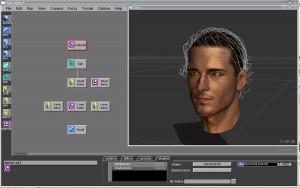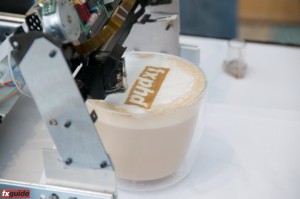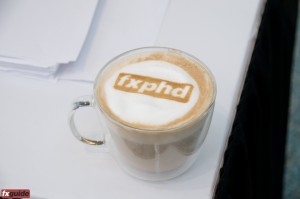With the trade show now open and the event fully under way we do a quick survey of cool events and tech on the Tuesday and Wednesday of this years Siggraph. Today we focus on XSI, Massive, C4D, RealFlow, coffee and the great Stan Winston.
The Studio Nights
 On each of the major nights of the show Siggraph presents what they are calling their Studio Nights. On the first night John Lasseter presented a documentary on the history of Pixar. But on Wednesday night there was a very special screening of Terminator 2, hosted by Sony Pictures, with an hour long panel very successfully moderated by Cinefex’s Jody Duncan. At the end of the panel, framed on either side of the stage by both the Terminator suit and the Iron Man Suit, James Cameron gave a very personal and heartfelt tribute to Stan Winston.
On each of the major nights of the show Siggraph presents what they are calling their Studio Nights. On the first night John Lasseter presented a documentary on the history of Pixar. But on Wednesday night there was a very special screening of Terminator 2, hosted by Sony Pictures, with an hour long panel very successfully moderated by Cinefex’s Jody Duncan. At the end of the panel, framed on either side of the stage by both the Terminator suit and the Iron Man Suit, James Cameron gave a very personal and heartfelt tribute to Stan Winston.
Cameron described the night as a celebration of a great man who liked in every picture he did to do things that had never been done before. Cameron spoke of speaking to Winston just days before he passed. During the conversation Cameron recounted how Stan Winston had remarked that once you had shown an audience an effect, then “anyone can do it” and you had to do something new. James Cameron was clearly moved by the night, and was pleased to see the large audience that had come to remember one of the giants of the our Industry.
Maxon C4D
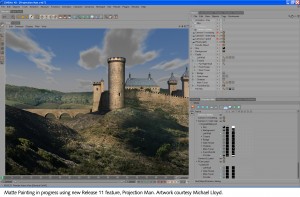
Creating quite a lot of interest this year was the Cinema 4D booth. One popular feature is improved camera mapping called – Projection Man. Leverage the original C4D matte painting system originally developed by MAXON exclusively for Sony Pictures Imageworks and recently used to create such feature films as Hancock, Speed Racer, Beowulf and Surf’s Up. This formerly exclusive toolset enhances workflow and makes it easy to create and patch the mattes.
Tight integration with Adobe Photoshop and MAXON BodyPaint 3D simplifies editing and manipulating extensive digital mattes and even fully immersive 3D environments.
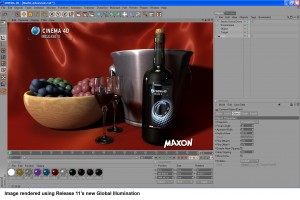
Also new: A radical reworked global illumination model, with enhanced cacheing, smoother flicker free animation, improved animation capabilities including a more flexible library of animation. Many user requested points have been addressed such as animation paths of constant velocity and Collada (interchange) support.
The rendering time has also been increased dramatically – it is up to twice as fast. Another popular move is Cineman which allows renderman rendering with C4D – with the preview window, you can produce RIB files or just render to Renderman directly from with the UI. C4D supports now Renderman,3Delight, AIR and others.
The Mac OSX version is 64 bit with quicktime support. CINEMA 4D R11 is the first comprehensive 3D package re-engineered to take full advantage of the Mac OS X 10.5 release. As a native 64-bit Cocoa application, C4D can be used in 64-bit mode to utilize greater RAM resources so you can build and render more complex projects. All 64-bit processors are supported. Users can easily switch between 32-bit and 64-bit mode to suit their individual needs.
RealFlow Users Group
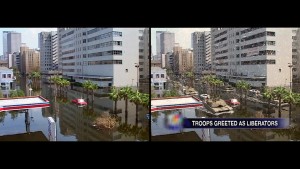
Siggraph is home to user groups big and small. A small but technically interesting user group this year was the RealFlow UG from Next technologies. While the audience may have been small compared with an Autodesk event, the content was every bit as interesting. There were both company presentations and user stories. RealfFlow has been used on many projects such as the brilliant SWAY U2 clip.
One stand out presentation was from Mark Stasiuk Co-founder of Fusion CI Studios, who is a CG Supervisor and RealFlow Expert. Mark worked with and along side Asylum on Nation Treasure Book of Secrets, and took the audience through a brilliant presentation on making normal gravity field water flow extend to roaring white water rapids.
The technique built on running low particle count simulations – extracting particles, tagging them and using them as locators for a series of intelligent vortexes and then re simulating with a much much higher particle count for a realistic and stunning result.
RealFlow which won the 2007 technical academy award, also showed their new Renderring Toolkit which allows for a major improvement in RealFlow simulations. The normal process for a large sim is to run the sim mesh and then render but the middle stage can be a real bottle neck as the sim particle count hits multimillion particle numbers. The new render tool kit allows meshing only at render time, which gets around a hug memory limit and literally allows for more complex scenes to actually be finaled. Realflow simulations that save the mesh particles actually meant that some shots would not be able to be memory managed to be rendered. As you can now you can do this in two steps and get meshing without having to have them in the scene the toolkit will be very popular with large studios .The kit will work with Mental Ray and Renderman. It comes in 2 parts one for meshing and one for particles.
(Flow-Mesher, FlowParticler)
There is also a new state of the art smooting algorithm which can render particles as points spheres or sprites
and most importantly modify the particles based on camera distance and mesh per frame. Thus particles hidden in the scene are never meshed and distance particles can be meshed more effectively.
In a technology showing RealFlow Version 5 was previewed. This will have a grid solver allowing for much larger water simulations, but it will blend seamlessly with the current approach allowing the current solution for say close breaking waves, and the grid solution for the vast body of water behind the wave.
XSI ICE
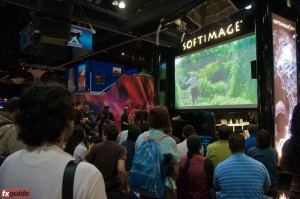
XSI was also extremely hot this year with large queues to see their new release and ICE. ICE is basically a graphical programing mode, that allows artists to work without coding. So effective is ICE that SoftImage’s own team use ICE to develop their own tools.
The fully programmable and extendible nature of ICE makes it perfect for pipeline development, and its state of the art implementation makes it very very fast. While the product suits pipeline automation, its strength is in mid size TVC focused facilities, as XSI lacks a Renderman implementation currently and the graphical UI makes workflow tool generation possible for less technical creative type artists, vs senior TDs.
In talking to users the primary reaction to the new tools are that they are ‘fun’ to use. The easy of working and speed of setting up even complex tasks makes it a joy to use. While it is robust and complex – some other products seem to have gotten bogged down in complexity and thus the artist strain to achieve establishing worklfows – ICE seems to free this us and artist we spoke to were responding favorably.
XSI also literally invited Vanilla Ice to play at the XSI party, and he actually impressed the crowd, people really seemed to enjoy the performance, but this begs the question who will they get next year … MC Hammer?
Motion Capture
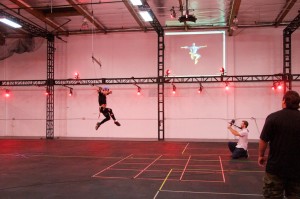
Motion capture seemed to be everywhere at Siggraph 2008, on the show floor almost every second booth seemed to have someone dancing, walking or flipping covered in dots and reflectors. The range of solutions stretched from the extremely powerful and benchmark Vicon system to cameraless and suitless systems.
Prices are also tumbling. The problem seems to be the volume of suits the industry needs. Few facilities need more than one or two motion capture stage, and even with falling prices, just how all these companies will survive is a serious question. There is no doubt the major players are well placed but many of the new comers may just fail to hit sufficient volume to remain viable.
The clear industry leader is Vicon and fxguidetv will be featuring them and others in an upcoming episode.
Massive Software
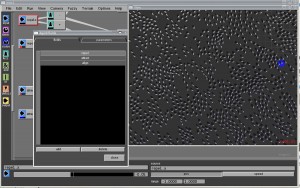 Massive allows artists to create and direct anything from CG humanoids to birds, animals, cars and more to deliver realistic and emotive virtual performances. Massive “agents” are 3D characters that use sight, sound and touch to interpret and react autonomously to the world around them.
Massive allows artists to create and direct anything from CG humanoids to birds, animals, cars and more to deliver realistic and emotive virtual performances. Massive “agents” are 3D characters that use sight, sound and touch to interpret and react autonomously to the world around them.
Released at Siggraph is version 3.5. As a point release, the new version achieves many user requested feature cleanups, such as allowing vector direction for the lanes feature launched in version 3.0. Int he past in maya cars would appear to be travelling sideways half the time as there was no way to preview the agents with their correct vector direction. Many similar points have been addressed such as improved collision detection in lanes, extended FBX support that now includes cameras, lights, geometry and skeleton and motion export.
There is now better Maya Particle File Support with improved integration with better support for Maya particle files. Using Maya particle files, a Massive simulation can be imported into a Maya scene as simple particles for scene integration, lighting reference and real time playback.
There is also Improved Dynamic Hair and Fur Support with increased control of hair with a guide hair shape constraint that can be used to get hair to keep to a user-defined shape or hairstyle. This provides Agents with more believable hair.
Interestingly Pixar used Massive extensively in WALL E and the lanes function in particular with fully procedural animation of the general Axiom robots, developed by Pixar’s Animation artists.
Fjorg
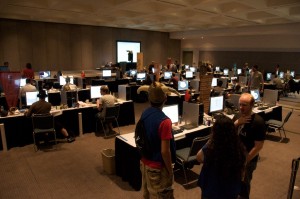
After 32 hours straight sixteen teams of die hard animators finished their creative marathon on Tuesday night. Each member of the three person teams was given a set of samples, files and a full suite of software & hardware to produce the best animation they could without stopping for 32 hours. The top three teams get not only prizes but access to senior animation studio executives and creative. Judging now begins to see which team has won, and which teams just missed most of Siggraph locked in a room doing what increasingly too many animators are asked to do… pulling an all nighter.
Great Stupid Invention of the Day Award
We found next to Starbucks in the main entrance to the show a small table with perhaps the most popular and silliest graphics invention at the show, a coffee latte printer from OnLatte. This caramelized sugar based solution allows artists (? Is that who they are ?) to print logos in on the froth of a latte. To make sure this was not some advanced hoax – we send a team down with an fxphd logo to see if they could print it – and sure enough our hardworking researchers were soon drinking branded lattes… heavily in the “what will they think of next” category that makes Siggraph such a wonderful show.
We will be showing this on episode of 31 of fxguidetv from siggraph.
Tomorrow Day 4 : Thurs.

